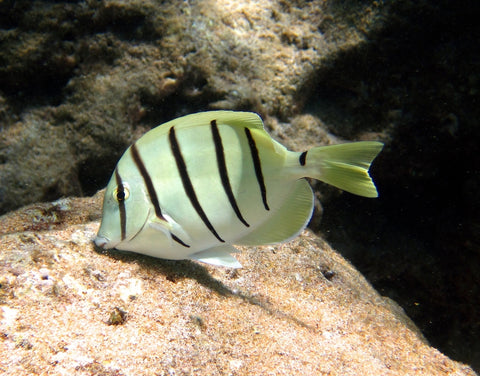
Description:
The Convict Tang is found widespread. They are found in the Indo-Pacific except for seas around the Arabian Peninsula, in the Pacific at the Hawaiian Islands, and in the Eastern Pacific they are found in the lower Gulf of California and down to Panama, including the Revillagigedo Islands, Clipperton Island, Cocos Islands, and Galápagos Islands with some reports throughout the Mediterranean and Adriatic Sea most likely entering through the Suez Canal. The convict tang is so called because of the 6 vertical, bold black stripes on its yellowish white body. The first black stripe passes through the eye. This tang could possibly be mistaken for a Zebra Tang, but a Zebra tang has 3 extra black stripes for a total of 9 stripes. These tangs will use their caudal spines as a weapon against other fish that threaten them. A Convict Tang can reach up to 8 inches in length and requires an aquarium of at least 125 gallons with live rock and plenty of room to swim.

Diet:
Tangs, in general, are primarily herbivores. They need rocks to graze on as their diet is primarily marine algae. For tanks on the smaller side that have less live rock to grow algae, you will need to supplement your tang’s diet with Nori or other vegetable matter like Nori, Romaine lettuce, spinach leaves, or broccoli. They also will accept flake foods and sometimes small meaty offerings like Mysis shrimp. A good variety of foods will keep your tang healthy and vibrant. A well-fed tang won’t pick at your corals, but there is always a possibility if there is no algae or Nori present. Also, a well-fed Tang has less chance of developing HLLE (Head and Lateral Line Erosion). HLLE can be fatal depending on severity and can leave lasting scars on the tang.

Behavior:
As stated earlier, a Convict Tang can reach up to 8 inches and requires an aquarium of at least 125 gallons with live rock and plenty of room to swim. Tangs, in general, will spend their days swimming from one side of the aquarium to the other, picking on any algae growing on your live rock or frag plugs. In the ocean, tangs swim great distances every day. This should give you an idea of how much swimming space a tang will need to be satisfied in your tank. It is also recommended that your tank be wider than it is tall, to allow them more space to swim. Without ample space to swim, a tang can become stressed and will be very prone to diseases like Ich.
Convict Tangs can be aggressive to other tangs, but are usually peaceful with other non-Tang species after they establish their place in the pecking order of the tank. With the spines built into their tails, they are usually at the top of that pecking order. Keeping your Convict Tang well-fed will reduce aggression in your reef. If you intend to keep fish, a netted lid is recommended.
